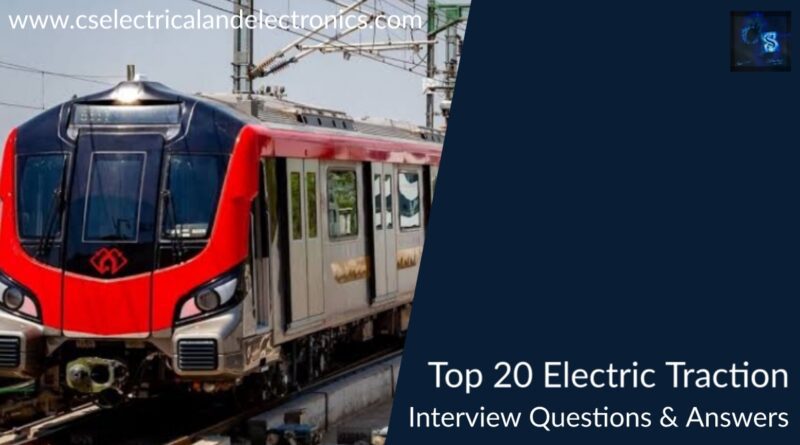Top 20 Electric Traction Interview Questions And Answers
Hello guys, welcome back to our blog. In this article, we will discuss the top 20 electric traction interview questions and answers, and electrical traction questions asked in interviews, and I will also try to keep answers short and easy to understand.
If you have any electrical, electronics, and computer science doubts, then ask questions. You can also catch me on Instagram – CS Electrical & Electronics.
Also, read:
- Top 10 Non-Renewable Power Plants In The World, Nuclear Power Plants.
- Top 10 Renewable Energy Power Plants In World You Must Know.
- Top 05 Ways To Make Money For Students, How Students Can Earn Money.
Electric Traction Interview Questions And Answers
01. What is Traction and mention its types?
A: The process of moving any vehicle such as trams, locomotives, etc is called Traction. Types of tractions are 1) Steam and Engine traction and 2) Electrical Traction.
02. What are the various systems of Traction?
A. The various systems of Traction are:
- Direct Steam engine drive
- Direct Internal combustion (IC) drive
- Internal Combustion engine electrical drive
- Electrical Drive system
- Electrical Battery traction system
03. What are the advantages of electrical traction?
A. The advantages of electrical traction are:
- High Starting torque and less maintenance.
- Cheapest method and the cleanest form of traction system.
- The great passenger capacity with high speed.
- High-efficient traction system compared to other traction systems.
04. What are the disadvantages of steam or IC Traction?
A. The disadvantages of steam or IC traction are:
- Low starting torque and high maintenance.
- It will produce smoke while running the locomotive which causes pollution to the environment.
- The cabins attached to the engine are very and the efficiency will be very less compared to Electrical traction.
05. Why electrical traction is mostly preferred compared to steam (or) Internal Combustion Engine drive?
A. Engines used in the IC engine drives will run at low rpm because of the heavy load on the back. If they run on the high RPMs there will be a chance of an explosion of the engine. The starting torque will be low due to less rpm. To overcome this electrical traction is used because the motors used in electrical drives can provide high starting torque at low rpm.
06. What are the different types of supplies used in Electrical Traction?
A. A.C. Supply, D.C. Supply, and Composite Supply. A.C supply is furtherly classified into two types Single phase and Three phase supply. Composite supply is used as Single phase AC-DC and Single phase – Three phases.
07. What are the different types of motors used in Electrical Traction?
A. The different types of motors used in electrical traction are:
- Three-phase induction motor
- Linear induction motor
- AC series motor
- DC series motor
- DC shunt motor
These are mainly used motors in electrical traction.
08. What is a Motor control center (MCC) and how it is used?
A. Motor Control Centre (MCC) is where all the electrical drives are connected together and controlled. It is used for controlling the torque and speed of the electrical motors in the Electrical traction.
09. What is Pantograph? How does it work?
A. Pantograph is one of the most important pieces of equipment used in electrical traction (Electrical trains). It is used in electrical trains to collect current from the overhead lines. It is popularly known as the current collector.
The overhead transmission lines are used for electric supply to trains so to supply that electricity the contact is important, so the Pantographs are used for the supply of current. There will be a contact between the strip and the wire. The pantograph contact will remain with the wire as the train starts running.
10. What is the major difference between Electrical and Steam traction?
A. Steam traction uses a different process to generate steam and run turbines hence the mechanical energy generated using steam will be used to generate electrical currents and run the motors. Coming to the electrical traction the electrical current will be directly collected from the overhead lines and from there the electrical energy is distributed to run motors.
11. What is Tractive Effort?
A. The force at the outer edges of the driving wheels of the moving trains is called tractive effort. It is popularly known as the sum of rolling force and tractive force.
12. What is Traction Voltage and determine India’s highest traction voltage?
A. The voltage passing through the overhead lines is called the Traction Voltage. The traction voltage will differ from country to country. In India 1.5kv DC and 25 KV, AC is the highest traction voltages.
13. What is Speed–Time Curve?
A. The curve drawn between the speed and time is called as speed-time curve. The motion of the train at different time instants and the acceleration of motors will be determined using a speed-time curve.
14. What type of braking is mostly used in Electrical traction?
A. Regenerative braking is mostly used in electrical traction because it is the most reliable braking system for electrical drives.
15. What is Emergency Braking?
A. Conventional braking system is a separate braking mechanism specially designed to stop a train as quickly as possible. A separate plunger is provided in the cabin for passengers to stop the trains in emergency situations.
16. What is the need for Traction Motor Control?
A. To get smooth acceleration without jerking and to limit the starting current there is a need for traction motor control.
17. What are the various methods of Traction motor control?
A. The traction motor control is basically used to control the speed of the dc series motor in traction. The various methods are:
- Field Control and Thyristor control
- Rheostatic Control
- Buck and Boost control
- Series parallel control
18. Which braking system is used in steam locomotives?
A. Vacuum braking system is mostly used in the steam locomotive as it is much more reliable in steam braking.
19. What are the main traction systems used in India?
A. The main traction system used in India are:
- Diesel traction
- Electrical Traction
- Steam engine traction
- Diesel-electric traction
20. What is the Third rail?
A. The process of providing power to the railway locomotive using a semi-continuous rigid conductor placed alongside or between the rails of a railway track. It is popularly known as the conductor rail.
I hope this article “Electric Traction Interview Questions And Answers” may help you all a lot. Thank you for reading.
Also, read:
- 10 Tips To Maintain Battery For Long Life, Battery Maintainance
- 10 Tips To Save Electricity Bills, Save Money By Saving Electricity
- 100 (AI) Artificial Intelligence Applications In The Automotive Industry
- 100 + Electrical Engineering Projects For Students, Engineers
- 1000+ Control System Quiz, Top MCQ On Control System
- 1000+ Electrical Machines Quiz, Top MCQs On Electrical Machines
- 1000+ Interview Questions On Java, Java Interview Questions, Freshers
- 1000+ MATLAB Simulink Projects For MTech, Engineering Students
Author Profile
- Content Writer
Latest entries
 All PostsNovember 29, 2021Overhead Line Components, Functions Of Components In Overhead Lines
All PostsNovember 29, 2021Overhead Line Components, Functions Of Components In Overhead Lines All PostsSeptember 26, 2021Types Of Devices Used To Improve Power Factor, Power Factor Correction
All PostsSeptember 26, 2021Types Of Devices Used To Improve Power Factor, Power Factor Correction All PostsJune 20, 2021Top 10 Universities For MS In The World, MS Universities In The World
All PostsJune 20, 2021Top 10 Universities For MS In The World, MS Universities In The World All PostsJune 20, 2021Top 10 Universities For MTech In The World, MTech Universities In World
All PostsJune 20, 2021Top 10 Universities For MTech In The World, MTech Universities In World








